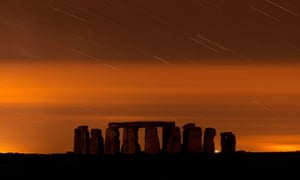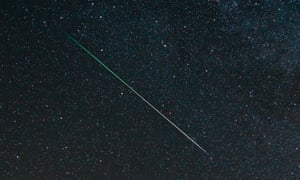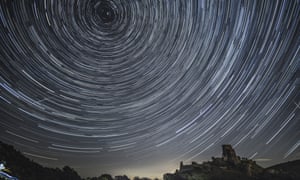From piquing the interest of astronomers to fuelling the musings of
poets, meteor showers have left a trail of inspiration in their wake
since humanity first peered up into the sky.
Now inspiration is set to strike once more. This weekend the night sky will be filled with glowing streaks as the annual Perseid meteor shower reaches its peak, with the best views in the northern hemisphere.
“People have looked up and noticed these showers and wondered about what they meant for thousands of years,” said Chris Lintott, professor of astrophysics at the University of Oxford and co-presenter of The Sky at Night.
The Perseid shower takes its name from the point in the sky from which the meteors appear to hail: the constellation of Perseus. Named after the mythical Greek hero who defeated the gorgon Medusa by cutting off her snake-covered head, the constellation can be seen in the northern sky.
But, as Lintott points out, you don’t need to be au fait with star charts to enjoy the show. “[It] doesn’t mean you should look towards Perseus,” he said. “You see more of the meteors when you are side on, so [look] east or west, and you’ll see them streaking past you.”

Now inspiration is set to strike once more. This weekend the night sky will be filled with glowing streaks as the annual Perseid meteor shower reaches its peak, with the best views in the northern hemisphere.
“People have looked up and noticed these showers and wondered about what they meant for thousands of years,” said Chris Lintott, professor of astrophysics at the University of Oxford and co-presenter of The Sky at Night.
The Perseid shower takes its name from the point in the sky from which the meteors appear to hail: the constellation of Perseus. Named after the mythical Greek hero who defeated the gorgon Medusa by cutting off her snake-covered head, the constellation can be seen in the northern sky.
But, as Lintott points out, you don’t need to be au fait with star charts to enjoy the show. “[It] doesn’t mean you should look towards Perseus,” he said. “You see more of the meteors when you are side on, so [look] east or west, and you’ll see them streaking past you.”

Best of all, says Lintott, it’s easy to revel in the celestial fireworks: just wrap up warm, let your eyes adjust to the dark and look up. “My favourite thing about meteor watching is that the only equipment you really need is a comfortable chair,” he said.
Dr Michele Bannister, an astrophysicist at Queen’s University Belfast, favours a different approach. She advises gazing up while lying on a tarpaulin and sleeping bag in order to get the widest view of the night sky.
The meteor shower is beautiful spectacle born of debris. Every year the Earth travels through dust shed by Comet 109P/Swift-Tuttle on its 133-year orbit of the sun. A “dirty snowball”, the comet last swept close to the sun in 1992 and is now far out in the solar system.
“It is in a dance with Jupiter at the moment,” said Bannister. “This comet makes one loop around the sun and Jupiter makes 11 loops.”
As our planet speeds through the comet’s train of dust, tiny particles the size of a grain of sand hit the Earth’s atmosphere at speeds of up to 132,000 mph, generating temperatures of thousands of degrees celsius.
“They are punching through the air at very high speed, so they compress the air in front of them,” said Marek Kukula, public astronomer at the Royal Observatory, Greenwich.
“This is a lot of compression – it heats the air and that is what causes that bright streak,” he said. “The meteor itself, the solid object, will burn up and that can also give you colours as the materials fluoresce.”

The Perseid shower is also famed for its fireballs: meteors that appear as bright as planets such as Venus or Jupiter, some of which explode. “[Fireballs are] just a little bit bigger and therefore a little bit brighter than your average meteor – but they can be pretty spectacular,” said Kukula. “They can actually have quite brilliant colours as well: reds and greens and blues.”
The glory of meteor showers, notes Kukula, would have been familiar to those who lived before the age of street lights. Indeed, it has been suggested that The Rime of the Ancient Mariner by Samuel Taylor Coleridge contains a nod to a flurry of shooting stars: “The upper air burst into life!” the poet wrote.
But while those in the dark of the countryside might catch the best glimpse of this weekend’s shower, seeing about 80-100 meteors per hour, even city dwellers can expect to catch a glimpse of a shooting star every few minutes Kukula said.
And while the waning gibbous moon could make some of the fainter meteors harder to see, experts say its still worth looking out. “If you want to see the best of the shower you want to get up in the early morning, after the moon has set,” said Lintott. “But even with the moon up, you will still see the brightest of the shower.”
The link between comets and meteor showers was only revealed in the 19th century, through the meticulous calculations of the Italian astronomer Giovanni Schiaparelli. But the discovery, say experts, only adds to the wonder of shooting stars.
“You can stop for a moment and [say] ‘gee, we live in this wonderful universe with such amazing long spans of time, and yet this [dust] that has been around for so long ends its life so briefly’,” said Bannister.
Lucie Green, professor of physics at University College London and a co-presenter of the BBC’s The Sky at Night, agreed. “There’s lots of things to see in the night sky and lots of beautiful sights but generally most people don’t get to see something which is dynamic, something which is changing,” she added.
Perseids: breathtaking timelapse video of meteor shower over California (archive video from 2013)
“I was fascinated by meteor showers already as a child,” she said. “To be aware that these dust grains which are 4.6bn years old, come from a comet – a real comet – and are delivered to Earth … I think that is wonderful.”
Carole Mundell, professor of extragalactic astronomy at the University of Bath, said it was “phenomenally thrilling” to realise that the meteors flashing 80km overhead are born of ancient particles. “These things are akin to the left over building rubble from the formation of the solar system,” she said. “It still stuns me every year really that as a species we are here to see it and we understand what the phenomenon is.”
Kukula agreed: “I think it is a myth that science takes away the romance. I think it adds [to it].”

No comments:
Post a Comment